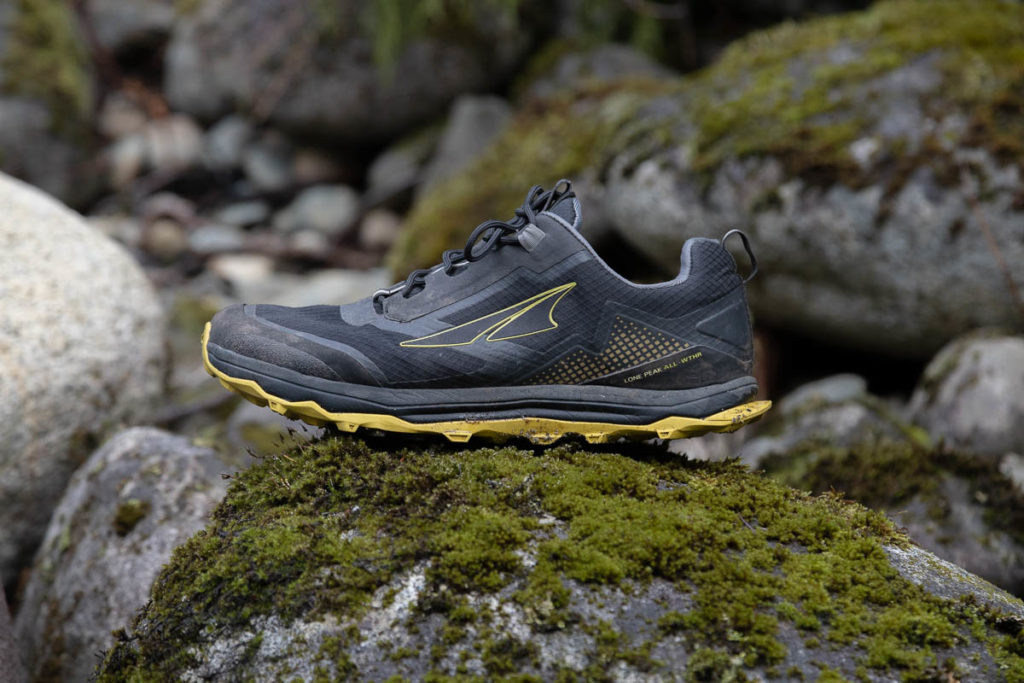Yes! You can absolutely hike in trail runners.
Trail runners work very well for hiking. They are lightweight, comfortable, breathable and less expensive. But there are a couple things to watch out for.
We’ll compare trail runners to hiking boots in this article but most of these arguments apply to hiking shoes as well.
Advantages to hiking in trail runners
Lighter
Trail runners are lighter than hiking boots. They’re meant for running so they have lighter soles and mesh uppers. They don’t have the tall ankles and often don’t have waterproof materials.
Lightweight trail runners are around 300 to 350 grams. The Altra Lone Peak 5 weighs 318 grams (11.1 oz), and the La Sportiva Bushido II weighs 298 grams (10.5 oz).
Larger hiking boots like the Tecnica Forge GTX weighs 595 grams (21 oz) or the Salomon X Ultra Mid 4 weighs 429 grams (15.1 oz). The thicker sole, beefier materials, waterproof membranes and taller ankles, all add 100 to 300 grams.
Cooler
Since trail runners are often mesh they are cooler than water resistant or waterproof hiking boots. Air can move in and out of the shoes keeping your feet dry and comfortable.
Fewer blisters
Lighter and more flexible materials give a closer fit with trail runners. Often you can hike with them right out of the box. An easier fit combined with good airflow through the mesh leads to less blisters from friction or sweaty feet.
More comfortable out of the box
Compared to larger, stiffer hiking boots, trail runners don’t need as much break-in time. Some people find they can just take them out of the box and go hiking
Less expensive
Trail runners are usually less expensive than hiking boots. They use less material and often have less structure and rigid parts to them.
From our examples above the Altra Lone Peak 5 trail runners come in at $175 CAD ($130 USD). And the La Sportiva Bushido II comes in at $160 CAD ($130 USD).
For boots, the lightweight Salomon X Ultra Mid 4 usually run $199 CAD ($165 USD) and the larger heat-moldable Tecnica Forge GTX is around $350 CAD ($270 USD).

Disadvantages to hiking in trail runners
Trail runners aren’t always rainbows and unicorns though. There are some downsides to them.
Not waterproof
There’s a caveat to this one. Many trail runners are mesh and very breathable. The increased airflow is more comfortable. Your feet dry faster after sweating or walking through rivers.
That said, most companies offer waterproof versions of some of their trail runners. They have the same waterproof membrane as in hiking boots. They’ll have the same downsides as a waterproof boot as well: less breathable, a bit more expensive, a bit heavier.
Less durable
Trail runners are not built to last as long as a hiking boot. If they were, they’d be as heavy as a hiking boot. Thru-hikers will go through multiple pairs of trail runners over months of hiking. For most the comfort, ease of movement and lack of blisters is worth it.
See Trail runners vs hiking boots below for an option that’s more durable but lighter weight than a hiking boot.
Less ankle protection
Boots have hiker ankles than trail runners. For bushwhacking or places that put your ankles at risk, consider taller boots. There’s still the comfort and weight to consider.
Trail runners vs hiking shoes
Hiking shoes are like smaller, lighter hiking boots. They have low ankles like a trail runner but tend to be a bit more durable, stiff and waterproof like a hiking boot.
They make for a good compromise between trail runners and hiking boots for when you need something a bit more rigid and durable but don’t want to lug the weight of a boot around.
A note on stability and stiffness
Hiking boots are stiffer in the midsole than trail runners. They often have a rigid shank in the sole that keeps the sole from bending too. They have stiff ankles that run higher up your leg.
This rigidity in the boots may help tired legs carry a big backpack but they’re also contributing to those tired legs. Lighter trail runners or shoes don’t weigh as much leaving some energy in your legs. It’s harder to feel the ground with stiff boot soles making foot placement more difficult.
If you have ankle issues, the extra stability might be worth the weight. For us, we definitely prefer the lighter weight and flexibility of the trail runners.
Can you always hike in trail runners?
If you’re always hiking in warmer weather then certainly trail runners are going to be more comfortable.
When the water gets wet and cool or snowy, then you have a choice to make. Trail runners can get through a bit of rain here and there and dry out. Days in the snow or hard rain will be uncomfortable.
The trick is to pick the features of a trail runner or a boot for the trail and weather conditions. It becomes another option to lighten the load when it’s warm or not as wet just like you’d take a warmer sleeping bag and 4-season tent out in the winter.
Happy trail running hiking!